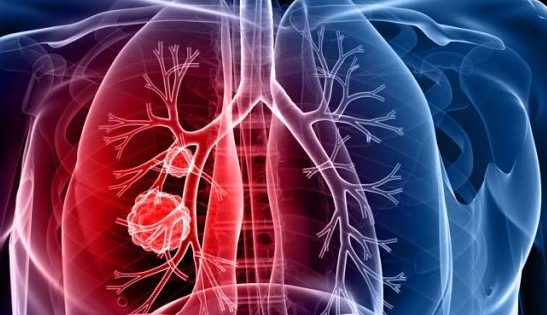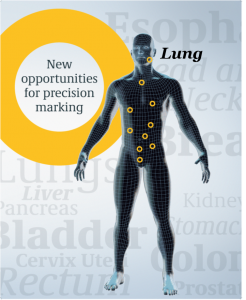Lung cancer
Radiation therapy plays an important role in the treatment of lung cancer
BioXmark® has shown to be suitable for target marking of lung tissue for image-guided radiation therapy of patients with locally advanced lung cancer

White paper: BioXmark® for high-precision radiation therapy of lung cancer
Discover the advantages of BioXmark® and the clinical evidence for its use to guide lung cancer radiation therapy:

Click to download the white paper
BioXmark® can facilitate precision radiation therapy for lung cancer
In one of two clinical study publications, Riisgaard de Blanck et al. conclude that BioXmark®
“was safe to endoscopically inject into primary tumors and lymph nodes in patients with locally advanced NSCLC and provided adequate visibility and stability when acting as fiducial markers for image guided radiotherapy”(1).
Click to read the study publication
Facts about lung cancer
In North America and Europe, lung cancer is the 2nd most common cancer with approximately 730,000 new cases (~11% of new cancer cases) and it is the leading cause of cancer-related mortality with approximately 544,000 deaths (~ 21% of cancer related mortality) in 2020(2).
Lung cancers are divided into non-small-cell lung cancer (NSCLC) (80-85%) and small-cell lung cancer (SCLC) (15% to 20%).
Smoking is the most important risk factor for lung cancer. Smokers have a 10 times higher risk of lung cancer than lifetime nonsmokers(3).
Clinical presentation and diagnosis
Lung cancers may present with different symptoms and common symptoms include cough, chest pain, hemoptysis, weight loss, dyspnea, hoarseness, tiredness and recurring pneumonia.
The diagnostic evaluation of patients with suspected lung cancer includes physical examination, chest X-ray, CT, PET/CT, MR and biopsy for pathology analysis (percutaneous or bronchoscopic)(3).
In the US a screening program has been implemented in high-risk groups and in many European countries national authorities are assessing implantation of similar risk based lung cancer screening(4,5).
There has been an increase in the detection of peripheral pulmonary nodules in recent years(6) and the implementation of low dose CT screening programs is expected to increase this trend, underpinning the need for less invasive strategies for diagnostic and therapeutic management of such nodules, which for the majority of cases of cases are benign(6,7).
Treatment
The treatment plan for lung cancer depends on many factors including the specific cancer type, and its stage as well as the patient’s age, general health condition and comorbidities. Treatment options can include surgery, radiation therapy, chemotherapy, targeted therapy, immunotherapy or a combination of therapies(8).
Radiation therapy for lung cancer
Radiation therapy plays an important role in the treatment of lung cancer. 77% percent of all lung cancer patients have an evidence-based indication for radiation therapy, even if it is often utilized less(9,10). The use of radiation therapy for lung cancer depends on the staging and the type of the disease.
SCLC is highly radiosensitive and thoracic radiation therapy has been shown to improve survival of SCLC patients(11). Chemotherapy combined with thoracic radiation therapy is considered the standard of care for this group of patients(9).
For NSCLC surgical resection is the treatment option with the highest potential to achieve full recovery. Radiation therapy with curative intent is used for patients who do not wish to have surgery, where surgery is contraindicated because of local spread or if the patient is not fit for surgery because of comorbidity. There is furthermore an ongoing debate about the role of radiation therapy in patients who are fit to undergo surgery(12).
For the majority of patients with stage III NSCLC, radiation therapy with concomitant chemotherapy is the standard of care. For patients with stage IV NSCLC radiation therapy is primarily used with a palliative aim, where it has a well-established role. Moreover, there may be a group of patients with oligometastatic disease where ablative treatment may result in long-term survival.
How can BioXmark® add value in the treatment of patients with lung cancer?
The performance(13), long term safety and visibility(1) of BioXmark® as a fiducial marker for radiation therapy of locally advanced NSCLC has been demonstrated in a study reported by Rydhög et al. and Riisgaard de Blanck et al.
In the study, 15 patients had in total 35 BioXmark® fiducial markers implanted, 1-4 markers in each patient. The patients were referred for concomitant chemoradiotherapy (66 Gy in 33 fractions, 5 weekly fractions). 11 markers were placed into or near the primary tumor and 24 markers were placed into the mediastinal lymph nodes(1,13).
2 patients did not proceed to radiation therapy leaving the evaluation to comprise 32 markers injected in 13 patients receiving radiation therapy.
29 of the 32 markers (91%) were suitable as fiducial markers on the planning CT and these markers remained fully visible on the CBCT-images throughout the treatment course(13).
Markers appeared more condensed when injected in the lymph nodes than in the tumors. No marker migration relative to the injection site was found in CT images up to 36 months after end of treatment.
Rydhög et al. conclude on the performance of BioXmark®:
“We found that the injected liquid fiducial markers were suitable for IGRT for locally advanced lung cancer patients”(13).
Riisgard de Blanck et al. conclude on the long-term safety and visibility of the marker that BioXmark®
“was safe to endoscopically inject into primary tumors and lymph nodes in patients with locally advanced NSCLC and provided adequate visibility and stability when acting as fiducial markers for image guided radiotherapy. The marker was partially degraded during a three year follow up. No post-RT marker migration or complication were found”(1).
References
1.
de Blanck SR, Rydhög JS, Larsen KR, Clementsen PF, Josipovic M, Aznar MC, et al. Long term safety and visibility of a novel liquid fiducial marker for use in image guided radiotherapy of non-small cell lung cancer. Clinical and Translational Radiation Oncology. 2018 Nov;13:24–8.
2.
GLOBOCAN 2020. Ferlay J, Ervik M, Lam F, Colombet M, Mery L, Piñeros M, Znaor A, Soerjomataram I, Bray F (2020). Global Cancer Observatory: Cancer Today. Lyon, France: International Agency for Research on Cancer. [Internet]. [cited 2022 Mar 10]. Available from: http://gco.iarc.fr/today/home
3.
Non-Small Cell Lung Cancer Treatment (PDQ®)–Health Professional Version – National Cancer Institute [Internet]. 2022 [cited 2022 Apr 7]. Available from: https://www.cancer.gov/types/lung/hp/non-small-cell-lung-treatment-pdq
4.
US Preventive Services Task Force, Krist AH, Davidson KW, Mangione CM, Barry MJ, Cabana M, et al. Screening for Lung Cancer: US Preventive Services Task Force Recommendation Statement. JAMA. 2021 Mar 9;325(10):962.
5.
2021-lung-cancer-screening-viewpoint_ecl_final.pdf [Internet]. [cited 2022 Apr 11]. Available from: https://www.cancer.dk/dyn/resources/File/file/0/9530/1641556029/2021-lung-cancer-screening-viewpoint_ecl_final.pdf
6.
Larici AR, Farchione A, Franchi P, Ciliberto M, Cicchetti G, Calandriello L, et al. Lung nodules: size still matters. Eur Respir Rev. 2017 Dec 31;26(146):170025.
7.
Casutt A, Kinj R, Ozsahin EM, von Garnier C, Lovis A. Fiducial markers for stereotactic lung radiation therapy: review of the transthoracic, endovascular and endobronchial approaches. Eur Respir Rev. 2022 Mar 31;31(163):210149.
8.
Head and Neck Cancers – National Cancer Institute [Internet]. [cited 2022 Mar 29]. Available from: https://www.cancer.gov/types/head-and-neck/head-neck-fact-sheet#r1
9.
Vinod SK, Hau E. Radiotherapy treatment for lung cancer: Current status and future directions. Respirology. 2020 Nov;25(S2):61–71.
10.
Barton MB, Jacob S, Shafiq J, Wong K, Thompson SR, Hanna TP, et al. Estimating the demand for radiotherapy from the evidence: A review of changes from 2003 to 2012. Radiotherapy and Oncology. 2014 Jul;112(1):140–4.
11.
Small Cell Lung Cancer Treatment (PDQ®)–Health Professional Version – National Cancer Institute [Internet]. 2022 [cited 2022 Apr 7]. Available from: https://www.cancer.gov/types/lung/hp/small-cell-lung-treatment-pdq
12.
Baker S, Dahele M, Lagerwaard FJ, Senan S. A critical review of recent developments in radiotherapy for non-small cell lung cancer. Radiat Oncol. 2016 Dec;11(1):115.
13.
Rydhög JS, Mortensen SR, Larsen KR, Clementsen P, Jølck RI, Josipovic M, et al. Liquid fiducial marker performance during radiotherapy of locally advanced non small cell lung cancer. Radiotherapy and Oncology. 2016 Oct;121(1):64–9.